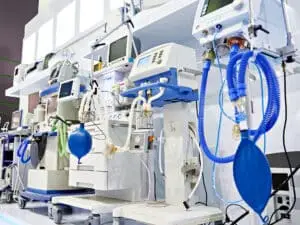Riding a motorcycle is undoubtedly dangerous. You face significant risks that other motor vehicle drivers do not. Your bike cannot protect you from the impact of another car. You are more prone to catastrophic injuries — even in an otherwise minor accident. A simple fender-bender can be deadly for a motorcyclist because of the lack of protection from the motorcycle itself.
Other drivers are often the reason for most of these dangers. Even if you ride safely, you cannot control what other drivers do on the road. Dealing with other motorists can be tricky and expose you to significant harm. Here, you can understand some of the risks motorcyclists face and the injuries you might suffer.
Motorcycle Accident Statistics in the United States
Motorcycle riders represent a significant portion of motor vehicle crashes and crash fatalities in the country. According to the National Highway Traffic Safety Administration, 5,932 motorcyclists were killed, representing 14% of traffic deaths.1 Fatalities in motorcycle crashes increased by 8% between 2020 and 2021, showing that this problem is not going away anytime soon.2
A major factor in motorcycle injuries and deaths is helmet use. According to the Insurance Institute for Highway Safety, Helmets are approximately 37% effective in preventing motorcycle fatalities and approximately 67% effective in preventing brain trauma.3 Of course, even those wearing helmets can be gravely injured in serious collision.
Every situation is different, but these statistics demonstrate just how serious a motorcycle crash can be.
Why Are Motorcycles So Dangerous?
There are several reasons that motorcycles are more dangerous than other motor vehicles.
Lack of External Protection
Cars, trucks, and SUVs have an outer frame that protects occupants from the majority of the impact. Motorcycles do not. Motorcyclists are fully exposed to other vehicles in a crash and can easily be thrown from the bike. Riders are often hit directly by the other car, which can crush bones and do further catastrophic damage to their body.
Motorcycle riders must rely on other protective gear to help keep them safe. This gear may include:
- Helmets
- Riding vests and pants
- Jeans and long-sleeved shirts
- Motorcycle gloves
- Boots
Harder To See on the Road
Motorcycles have a thin profile that is harder for other vehicles to see. This is especially true at night. Most motorcycles have a single taillight, and many are difficult for other drivers to see. If a driver is not paying close attention to the road, you are at even higher risk.
Many drivers fail to check their blind spots or even look at all when changing lanes. A sideswipe can knock you off of the road and lead to a very serious crash. This is even more dangerous when traveling on the highway, considering the high speeds and risk of hitting yet more vehicles on the road.
Less Steady on Two Wheels
Motorcycles typically have only two wheels and require you to balance your bike. On your own, this is not difficult. Good riders can easily control their vehicle and enjoy the feeling of freedom and excitement from riding a motorcycle.
The simple fact is, however, that two wheels are much less secure than the four wheels offered by most other motor vehicles. A low-speed accident that would not harm two cars can be fatal for a motorcyclist. You are easily knocked over, thrown from the motorcycle, or even run over by a negligent driver.
Common Causes of Motorcycle Accidents
Motorcycle accidents are a leading cause of death and catastrophic injuries in the country. Reasons for motorcycle accidents often include the following:
- Speeding. Motorcyclists or other drivers who speed often lose control and cause serious accidents. Riding at a responsible speed may reduce the risk of injuries.
- Driving Under the Influence. Motorcyclists or other drivers under the influence of drugs and alcohol are a danger to others. Their delayed reaction times, impaired judgment, and lack of motor control increase the risk of severe motorcycle accidents.
- Distracted Drivers. Distracted driving continues to be a major problem. Many drivers are more focused on their phones or other distractions than on the motorcyclist beside them.
- Lane Change Violations. Too many drivers fail to signal when changing lanes or to check that the coast is clear. Motorcyclists are at increased risk for this, as they are harder to see anyway. Drivers who check too quickly or not at all are likely to hit and knock over a motorcycle.
- Dangerous Road Conditions. Slippery roads can be especially hazardous for these two-wheeled vehicles. The same is true of loose debris such as gravel or even freshly cut grass.
- Tailgating. Other drivers may tailgate your motorcycle and drive too closely to you. A rear-end collision can launch you from the motorcycle and cause devastating harm.
Motorcycle Crash Injuries
Motorcycle collisions can lead to catastrophic injuries. Common motorcycle injuries include:
- Skin damage and road rash
- Crushed and broken bones
- Burns
- Amputations and loss of limb
- Organ damage or loss
- Mental and emotional trauma
- Concussions and traumatic brain injuries
- Spinal cord damage and back injuries
- Paralysis, either partial or total
- Death
These injuries are painful, debilitating, and expensive. You may need hospitalization, surgery, and other ongoing medical treatment. It can lead to lost income and many other financial hardships for you and your family. Many injured motorcyclists can seek compensation for these injuries through a personal injury lawsuit.
The Dangers of Motorcycles
Motorcycles are one of the most fun travel methods, but they can also be dangerous. As a motorcyclist, you must be keenly aware of your surroundings to help prevent this harm. Wearing the appropriate protective gear and practicing defensive motorcycle driving techniques can help, but ultimately you may not have control over whether you are injured.
Other drivers are usually the cause of motorcycle accidents. Injured drivers may be entitled to monetary compensation for their injuries in a personal injury lawsuit.
SOURCES:





